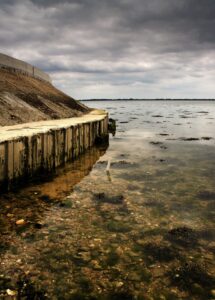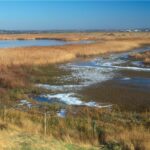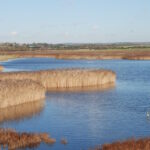Farlington Marshes Nature Reserve sits within Langstone Harbour, down on the busy south coast of Hampshire. Managed by Hampshire and Isle of Wight Wildlife Trust since the 1960s, it forms one of the most important sites in the Solent for overwintering waders and wildfowl, as well as providing a very important role for local breeding waders.
It is an artificial peninsula that was created in the late 18th century and has provided a series of roles over the last 260 years. This has consisted of grazing land, an Oyster fishery, and a successful decoy site to draw bombs away from Portsmouth in WW2. It is an important historical site, a local recreation area, and beauty spot, providing a slice of the countryside in a heavily urban environment.
However, its real beauty lies in its ecological importance. It is the keystone in a series of features throughout the harbour complex. Most bird species that utilise the harbour, at some point in their daily cycle, end up at Farlington. This may be for feeding, roosting, making use of freshwater, or just riding out a storm in a sheltered spot. This is becoming increasingly important as climate change and subsequent sea-level rise have meant many areas within the harbours have become less suitable and more frequently impacted by storm events. Furthermore, increased development and increasing recreational pressure are also exacerbating disturbance, particularly on smaller coastal sites.
Winter always sees a profusion of bird species at Farlington. Curlew were numerous as recently as the 80s or 90s but, mirroring national trends, have seen a large decline in recent years. This is a worrying reflection of the poor breeding success that this species and many other ground-nesting waders face across the country. Lapwing, for instance, used to number 2000 in the wintering flock at Farlington. Now the number is just 200.
Two years ago, there was a sudden upsurge in Curlew numbers at Farlington. We would normally get a handful cruising around the main marsh, feeding in the soft grassland but numbers were never high. Suddenly the numbers shot up to around 150. These would be mingled with the couple of thousand Brent Geese that feed on the short grassland throughout the coldest periods of winter.
Why the sudden increase in Curlew? Well, after doing some research it turned out that a main Curlew wintering site, only a couple of miles away, had been earmarked for development. The management of the site had stopped, leading to grassland that was not appropriate for feeding waders, becoming long, scrubby, and with new dog walking pressure.
This is an important event, as it highlights the need for Farlington and its deep importance within the landscape. When a site is lost or the land use changed, Curlew have to find alternative sites, they fall back to Farlington. Well managed and with very low disturbance, it means that when many of these birds lose their usual haunts, they have a safe space to retreat to.
You see it regularly through the winter. When a big storm rolls through, species such as Dunlin and Oystercatcher that prefer to sit out on the offshore islands, huddle down on the main marsh. Safe from washing away and the worst of the winds, they sit it out in relative safety.
On top of its overwintering achievements, Farlington is a stronghold for several breeding waders. Lapwing, Redshank, and Avocet all do very well here, with a smattering of Oystercatchers now joining them every year. We get good numbers, especially of Lapwing with roughly 30 pairs each year. The important thing is that they are all highly successful in fledging young as well and adding to the local population. Farlington is one of a few sites in Hampshire that regularly produces wader chicks and importantly chicks that make it to fledging.

The constant loss of good feeding and roosting sites puts more pressure on Farlington and highlights its importance in the Solent. However, its future is not secure. The seawall, built in the 1960s, is constantly crumbling back into the sea as the constant wave pressure erodes it. We’ve seen major defects occur in the last couple of years and the reality is that at any moment, it could catastrophically breach. This would be complicated to repair, if not impossible and could see an irrevocable change in the harbour.
Normally the coastline is a fluid, chaotic being. With storms and the constant movement of water shifting the coastline in or out, depositing material in one place and taking away in another. The trouble with the Solent coast, one of the most highly developed areas in the UK, is that natural processes are stopped by hard engineering. The hand of Canute has been realised through civil engineering and multimillion-pound government schemes. Movement is no longer permitted yet sea-level rise continues, leading to a process known as coastal squeeze. Habitats that would host our bird species no longer form and are being constantly lost. Farlington was claimed from the sea many years ago and now, it seems it is destined to return.

Farlington is under threat. There is a plan to replace the crumbling seawall, but this is under scrutiny and is not a guarantee. There is the wider picture to think of too. What about the long term? Is it feasible to hold the defences for the next 100 years? Probably not with the rate of sea-level rise. This means Farlington will need to be replaced nearby, an undertaking that is not only complex from a legal standpoint but almost impossible when you realistically look at the growing urban sprawl of the south coast. More importance needs to be placed on these areas, not just for flood defence and recreational benefits but for their pure ecological importance.
There is time to change though. You can help start the process through voicing your opinion. If you love Farlington and you recognise its importance, you can respond to this survey being carried out by the Environment Agency by the 19th of February 2024.
Guest blog post authored by Jamie Marsh (Director of Wilder Wight & Seas at Hampshire & Isle of Wight Wildlife Trust) & Chris Lycett (Senior Reserves Officer at Hampshire & Isle of Wight Wildlife Trust).



